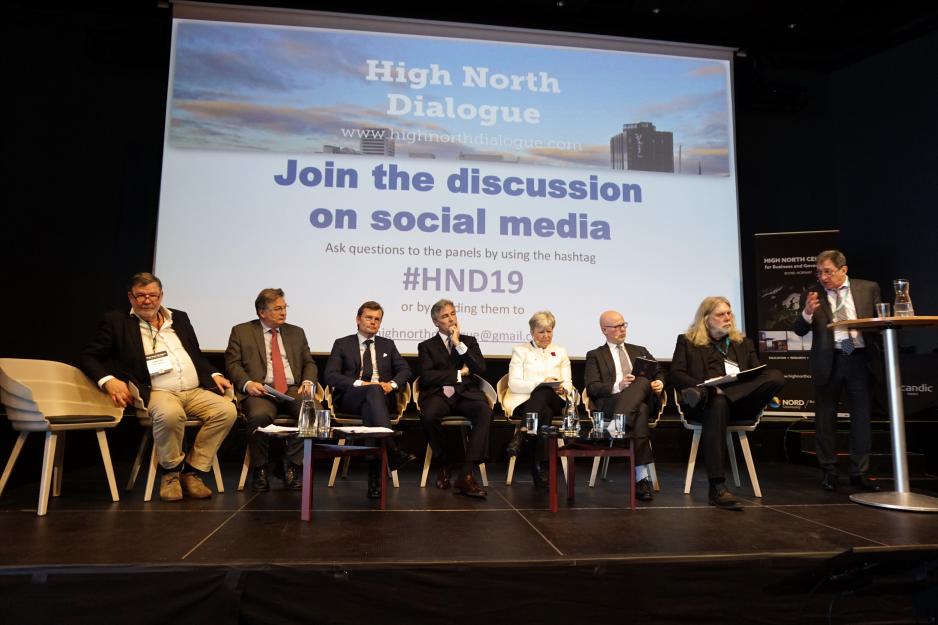After The Dialogue: We Must Clean Up Before Our Youth Move In

State Secretary Audun Halvorsen of the Norwegian MFA; Marie-Anne Coninsx, the EU’s Ambassador at Large for the Arctic; Mikael Antell, Finland’s Ambassador to Norway; Teimuraz O. Ramishvili, Russian Ambassador to Norway; Krister Bringéus, Sweden’s Ambassador to Norway; Kenneth J. Braithwaite, the USA’s Ambassador to Norway; and Kenneth Macartney, Chargé d’Affaires at the Canadian Embassy in Oslo, gathered on one stage during the High North Dialogue in Bodø on Thursday. (Photo: Amund Trellevik)
The scene is usually set like this: The youngsters have been home alone, and there is an urgent need for cleaning up. In the Arctic, however, the situation is quite opposite.
Following a long-lasting home-alone party for adults, a thorough cleaning up is needed before the coming generations of northerners assume power.
I have just left the arena following two days as participant, journalist and moderator at the High North Dialogue conference in Bodø. Those who argue that there has been an inflation in Arctic conferences probably have a point, though I do not necessarily agree. The conference arenas have a vast geographic range, and they also have vastly different contents and complement each other rather than compete.
Security policy
High North Dialogue is characterized by aiming particularly at the younger generations, at those who are to assume power in eight Arctic states. Both the program, the participants and the many debates reflect this. Today’s top leaders here face those who are on the threshold waiting to take over.
They meet in a time of great uncertainty paired with great opportunities.
Insecurities are first and foremost tied to the current security policy situation, climate challenges and an ageing and, with time, declining population.
The Arctic is still described by the states involved as a low-tension area, however, as State Secretary Audun Halvorsen of the Norwegian MFA said when meeting with ambassadors from a.o. Russia and the USA: We cannot take that for granted.
Or in the words of Kenneth J. Braithwaite, when I asked him whether the Arctic still is a lot-tension area:
- We do not consider Russia a threat, but a concern.
At the same time as his statement came on the HND stage in Bodø, NATO’s Secretary-General and former Norwegian Prime Minister Jens Stoltenberg brought the same worry into the American Congress. Using the alleged Russian violations of agreements limiting production and use of nuclear missiles as the main reason, Stoltenberg was repeatedly interrupted by American applause when continuing to push up NATO’s national defense budgets.
Nevertheless, in the Arctic, dialogue is still to play the main part.
The climate threat
If dialogue is what it takes to keep the Arctic peaceful, dialogue is nevertheless not enough by far when it comes to the climate threat, if we are to believe our offspring. Dialogue must be replaced by action.
That is why this is where the clean-up has to start. Because just like climate change, the declining population also constitutes a major threat to the High North.
Simply put, we must clean up in the Arctic in order to make it an attractive region in which young people want to settle down. Colorful descriptions of the joys of living in the High North from those of us who are already convinced, and also blessed with a solid dose of well-wishing towards climate changes happening around us, will no longer do the trick.
Business in the Arctic is definitely about to make the necessary transition, though it is– to a far too high degree – still subject to decisions made further south.
- The development of necessary tools often takes place in the south, but are these tools fit for the High North? Dean Erlend Bullvåg at Nord University Business School asked after his presenting an abundance of numbers and statistics that demonstrate the potential of the international High North.
Erlend Bullvåg could have dropped the question mark.

